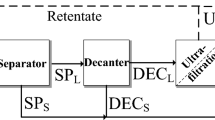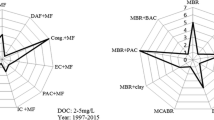Abstract
This study investigated the influence of membrane property and feed water organic matter quality on the permeate flux and water quality during gravity-driven membrane (GDM) filtration. GDM filtration was continuously carried out over 500 days at hydrostatic pressure of 65 mbar in dead-end mode without any back-flushing or membrane cleaning. Three ultrafiltration (UF) membranes (PES-100 kDa, PVDF-120 kDa, and PVDF-100 kDa) and one microfiltration (MF) membrane (PTFE-0.3 μm) were tested for treating lake water with varied organic matter qualities due to algal growth. The fluxes of the four membranes rapidly decreased to ~8 L/(m2 × h) within a week of GDM filtration. The flux variations were quite similar for the four membranes during the entire GDM filtration, indicating that membrane property has a little effect on the flux. The flux strongly depends on the feed water organic matter quality. The average flux in treating low organics containing water (7–60 days) was ~5 L/(m2 × h) and decreased to ~2 L/(m2 × h) in treating high organics containing water (60–300 days). The accumulation of algal-derived biopolymers was mainly responsible for the flux decline by forming biofilms with high permeation resistance. The average flux in 300–500 days increased to ~3.5 L/(m2 × h) when the feed water contained lower levels of biopolymers and higher levels of easily biodegradable organics, which created open and heterogeneous biofilms with lower permeation resistance. Removal efficiency for Escherichia coli was more than 5 log, while the removal efficiency for total bacterial cells was 1 log–2 log for the four membranes, indicating some bacterial regrowth after the filtration. Removal efficiency for the MS2 phage was 2.4 log and 1.5 log for the fouled PES-UF and PTFE-MF membranes.








Similar content being viewed by others
References
Cho M, Chung H, Choi W, Yoon J (2005) Different inactivation behaviors of MS-2 phage and Escherichia coli in TiO2 photocatalytic disinfection. Appl Environ Microbiol 71:270–275
Chomiak A, Sinnet B, Derlon N, Morgenroth E (2014) Inorganic particles increase biofilm heterogeneity and enhance permeate flux. Wat Res 64:177–186
Chomiak A, Traber J, Morgenroth E, Derlon N (2015) Biofilm increases permeate quality by organic carbon degradation in low pressure ultrafiltration. Wat Res 85:512–520
Chon K, Lee Y, Traber J, von Gunten U (2013) Quantification and characterization of dissolved organic nitrogen in wastewater effluents by electrodialysis treatment followed by size exclusion chromatography with nitrogen detection. Wat Res 47:5381–5391
Derlon N, Peter-Varbanets M, Scheidegger A, Pronk W, Morgenroth E (2012) Predation influences the structure of biofilm developed on ultrafiltration membranes. Wat Res 46:3323–3333
Derlon N, Koch N, Eugster B, Posch T, Pernthaler J, Pronk W, Morgenroth E (2013) Activity of metazoan governs biofilm structure formation and enhances permeate flux during gravity-driven membrane (GDM) filtration. Wat Res 47:2085–2095
Derlon N, Mimoso J, Klein T, Koetzxch S, Morgenroth E (2014) Presence of biofilms on ultrafiltration membrane surfaces increases the quality of permeate produced during ultra-low pressure gravity-driven membrane filtration. Wat Res 60:164–173
Duek A, Arkhangelsky E, Krush R, Brenner A, Gitis V (2012) New and conventional pore size tests in virus-removing membranes. Wat Res 46:2505–2514
ElHadidy AM, Peldszus S, Van Dyke MI (2014) Effect of hydraulically reversible and hydraulically irreversible fouling on the removal of MS2 and φX174 bacteriophage by an ultrafiltration membrane. Wat Res 61:297–307
Hagen K (1998) Removal of particles, bacteria and parasites with ultrafiltration for drinking water treatment. Desalination 119:85–91
Hammes FA, Egli T (2005) New method for assimilable organic carbon determination using flow-cytometric enumeration and a natural microbial consortium as inoculum. Environ Sci Technol 39:3289–3294
Hammes F, Berney M, Wang Y, Wital M, Köster O, Egli T (2008) Flow-cytometric total bacterial cell counts as a descriptive microbiological parameter for drinking water treatment processes. Wat Res 42:269–277
Huber SA, Balz A, Abert M, Pronk W (2011) Characterization of aquatic humic and non-humic matter with size-exclusion chromatography-organic carbon detection-organic nitrogen detection (LC-OCD-OND). Wat Res 45:879–885
Jermann D, Pronk K, Meylan S, Boller M (2007) Interplay of different NOM fouling mechanisms during ultrafiltration for drinking water production. Wat Res 41:1713–1722
Klein T, Zihlmann D, Derlon N, Isaacson C, Szivak I, Weissbrodt DG, Pronk W (2016) Biological control of biofilms on membranes by metazoans. Wat Res 88:20–29
Kodaka H, Mizuochi S, Teramura H, Nirazuka T (2006) Comparison of the compact dry EC with the most probable number method (AOAC official method 966.24) for enumeration of Escherichia coli and coliform bacteria in raw meats. Performance-Tested Method 110402. J AOAC Int 89:100–114
Lee N, Amy G, Croue JP (2006) Low-pressure membrane (MF/UF) fouling associated with allochthonous versus and autochthonous natural organic matter. Wat Res 40:2357–2368
Lee Y, Imminger S, Czekalski N, von Gunten U, Hammes F (2016) Inactivation efficiency of Escherichia coli and autochthonous bacteria during ozonation of municipal wastewater effluents quantified with flow cytometry and adenosine tri-phosphate analyses. Wat Res 101:617–627
Lu R, Mosiman D, Nguyen TH (2013) Mechanisms of MS2 bacteriophage removal by fouled ultrafiltration membrane subjected to different cleaning methods. Environ Sci Technol 47:13422–13429
Malaeb L, Le-Clech P, Vrouwenvelder JS, Ayoub GM, Saikaly PE (2013) Do biological-based strategies hold promise to biofouling control in MBRs? Wat Res 47:5447–5463
Meng F, Chae SR, Drews A, Kraume M, Shin HS, Yang F (2009) Recent advances in membrane bioreactors (MBRs): membrane fouling and membrane material. Wat Res 43:1489–1512
Peter-Varbanets (2015) Gravity-driven membrane disinfection for household water treatment. Final report: GDMD project 2010-2014. Eawag. https://www.eawag.ch/fileadmin/Domain1/Abteilungen/eng/projekte/trinkwasser/gdm/Ab_6796.GDMD_final_report_Peter_032015.pdf. Accessed 22 Nov 2016
Peter-Varbanets M, Hammes F, Vital M, Pronk W (2010) Stabilization of flux during dead-end ultra-low pressure ultrafiltration. Water Res 44:3607–3616
Peter-Varbanets M, Margot J, Traber J, Pronk W (2011) Mechanisms of membrane fouling during ultra-low pressure ultrafiltration. J Mem Sci 377:42–53
Wang Y, Hammes F, Boon N, Egli T (2007) Quantification of the filterability of freshwater bacteria through sterile 0.45, 0.22 and 0.1 mm pore size filters and shape-dependent enrichment of filterable bacterial communities. Environ Sci Technol 41:7080–7086
Acknowledgements
This work was supported by the “Climate Technology Development and Application” research project (K07722) through a grant provided by GIST in 2017. The authors would like to thank Dr. Pronk (Eawag) for his advice on the experimental setup.
Author information
Authors and Affiliations
Corresponding author
Additional information
Responsible editor: Angeles Blanco
Electronic supplementary material
ESM 1
Four figures as additional data for the organic matter and total bacterial cell analysis. (DOCX 1731 kb)
Rights and permissions
About this article
Cite this article
Lee, D., Lee, Y., Choi, S.S. et al. Effect of membrane property and feed water organic matter quality on long-term performance of the gravity-driven membrane filtration process. Environ Sci Pollut Res 26, 1152–1162 (2019). https://doi.org/10.1007/s11356-017-9627-8
Received:
Accepted:
Published:
Issue Date:
DOI: https://doi.org/10.1007/s11356-017-9627-8




